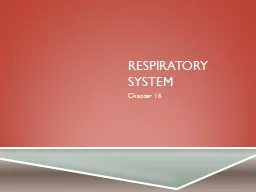

Components Tubes that filter incoming air Air transported to alveoli gas exchange respiration Respiration process of gas exchange between atmosphere and body cells Consists of Ventilation G ID: 913124
Download Presentation The PPT/PDF document "Respiratory System Chapter 16" is the property of its rightful owner. Permission is granted to download and print the materials on this web site for personal, non-commercial use only, and to display it on your personal computer provided you do not modify the materials and that you retain all copyright notices contained in the materials. By downloading content from our website, you accept the terms of this agreement.
Slide1
Respiratory System
Chapter 16
Slide2Components
Tubes that filter incoming air
Air transported to alveoli (gas exchange)
Slide3respiration
Respiration: process of gas exchange between atmosphere and body cells
Consists of
Ventilation
G
as
exchange between
blood
and
lungs
G
as
transport in the
bloodstream
G
as
exchange between the blood
and
body
cells
C
ellular
respiration
Slide4organs
Upper Respiratory
Tract (nose, nasal cavity,
sinuses
, and
pharynx)
Lower
Respiratory Tract (larynx, trachea,
bronchial
tree, and
lungs)
Slide5Front
alsinus
Nasal
cavity
Oral
cavity
Larynx
Bronchus
Hard
palate
Nostril
Right lung
Left lung
Trachea
Soft palate
Pharynx
Epiglottis
Esophagus
Slide6nose
Supported
by bone and
cartilage
Provides
an entrance for air
Nostril hair filters air
Slide7Nasal cavity
Posterior to nose
Cavity has passageways
Lined
with mucous
membranes
and help increase the
surface
area available to warm and filter
incoming airParticles in air can get trapped in mucus….What will flush the mucus out?Where will mucus go?
Slide8Sinuses
Air filled spaces in skull
Open to nasal cavity
Lined with mucus
Function: lighten skull; resonates voice
Slide9pharynx
Food and air pass through
Helps produce speech sounds
Slide10Frontal sinus
Nostril
Hard palate
Uvula
Tongue
Epiglottis
Hyoid bone
Larynx
Trachea
Superior
Middle
Inferior
Sphenoidal sinus
Pharyngeal tonsil
Nasopharynx
Opening of
auditory tube
Palatine tonsil
Oropharynx
Lingual tonsil
Laryngopharynx
Esophagus
Nasal
conchae
Slide11larynx
Between pharynx and trachea
Functions:
Prevents particles from entering trachea
Holds vocal cords
Slide12Trachea
Epiglottic cartilage
Hyoid bone
Thyroid cartilage
Cricoid cartilage
Hyoid bone
Epiglottic cartilage
Thyroid cartilage
Cricoid cartilage
Trachea
Slide13Vocal cords
Two pairs
Changing tension controls pitch
Changing force of air controls loudness
Slide14Epiglottis
Flap that covers trachea during swallowing
Slide15trachea
Anterior to esophagus…..why?
Extends into thoracic cavity
Separates into right and left bronchi
Inner wall lined with cilia and mucus……why?
20 cartilaginous rings
Slide16Bronchial tree
Branched tubes leading from trachea to alveoli
Starts with two main bronchi (right and left….each leads to a lung)
Bronchi lead to bronchioles
Slide17alveoli
Bronchioles lead to alveolar ducts, which lead to alveolar sacs, then end in alveoli
Gas exchange between blood and air
Slide18Larynx
Trachea
Left superior
(upper) lobe
Left inferior
(lower) lobe
Right middle lobe
Right superior (upper) lobe
Right main (primary)
bronchus
Lobar (secondary)
bronchus
Segmental (tertiary)
bronchus
Right inferior (lower) lobe
Alveolar duct
Alveolus
Terminal bronchiole
Respiratory bronchiole
Slide19Pulmonary
vein
Pulmonary
artery
Pulmonary
arteriole
Pulmonary
venule
Intralobular bronchiole
Alveolus
Terminal
bronchiole
Smooth muscle
Alveolar
duct
Alveolar
sac
Alveoli
Capillary network on
surface of alveolus
Blood flow
Blood flow
Respiratory
bronchiole
Slide20Slide21lungs
Right and left
Right has 3 lobes, left has 2 lobes
Separated by mediastinum
Enclosed by diaphragm and thoracic cage (ribs)
Bronchus and blood vessels enter each lung
Slide22Pericardial
cavity
Heart
Left pleural
cavity
Parietal
pleura
Visceral
pleura
Plane of
section
Right pleural
cavity
Pericardium
Pleura
Slide23Breathing mechanism
Ventilation
Composed of two parts: inspiration and exhalation
Slide24Inspiration
Flow of air into lungs
Diaphragm and intercostal muscles contract
The size of the thoracic cavity increases
Increase in volume of cavity = decrease in pressure so air flows from high to low pressure
Slide25Slide26exhalation
Air leaving lungs
Largely
a passive process which depends on natural lung elasticity
As muscles relax, air is pushed out of lungs
Slide27Slide28Diaphragm
Intra-alveolar
pressure
(758 mm Hg)
Intra-alveolar
pressure
(760 mm Hg)